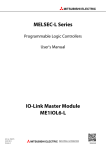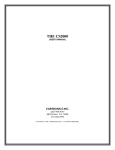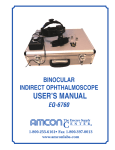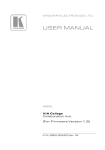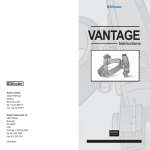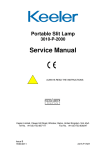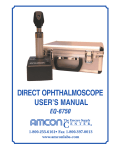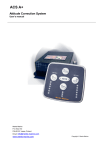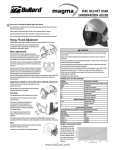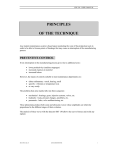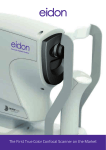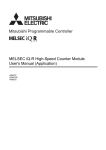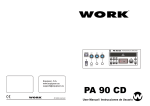Download English - Keeler Support
Transcript
VANTAGE Instructions Keeler Limited Clewer Hill Road Windsor Berks SL4 4AA Tel: +44 (0) 857177 Fax: +44 (0) 857817 Keeler Instruments Inc. 456 Parkway Broomall PA 19008 USA Toll Free: 1 800 523 5620 Tel: 610 353 4350 Fax: 610 353 7814 EP59-09548 Francais Deutch Italiano Espanol English Mode d’emploi PRIERE DE LIRE ATTENTIVEMENT CE MODE D’EMPLOI A RESPECTER MINUTIEUSEMENT Gebrauchsanleitung Bitte lesen und befolgen Sie diese Anleitung sorgfältig Istruzioni LEGGERE E SEGUIRE ATTENTAMENTE QUESTE ISTRUZIONI Instrucciones LEA ESTAS INSTRUCCIONES Y SIGALAS CUIDADOSAMENTE User Manual Please read and follow these instructions carefully Introduction Thank you for purchasing the Keeler Vantage Indirect Ophthalmoscope. We have taken the greatest care in the design, development and manufacture of this product to ensure that you get many years of troublefree service. However, it is important that you read the descriptions, installation and operating instructions carefully prior to installing or using your new indirect English Ophthalmoscope. 2 Contents Description of the Product Headband ................................................................................ 98 Optics ..................................................................................... 100 Using the Vantage ...................................................... 102 Accessories Teaching Mirror ..................................................................... 107 Sterilisable Levers .................................................................. 108 Rubber Eyepiece Caps .......................................................... 108 Plano Lenses ......................................................................... 108 Cleaning Instructions ................................................. 109 Sterilisation Procedures ............................................ 109 Bulb Replacement ...................................................... 109 Servicing .................................................................... 109 How to use a Binocular Indirect Ophthalmoscope .......................................... 110 Kitting Lists ................................................................ 116 English As part of our policy for continued product development we reserve the right to amend specifications at any time without prior notice. 3 Description of the Product B F G E A D English C 4 Description of the Product A Headband Size Adjustment Knob (Occipitally) B Headband Height Adjustment Knob (Cranially) C Metal Outer Brow Band D Brow Band Tension Knob E Ophthalmoscope Angle Knob F Leather Comfort Pads English G Hinge System 5 Description of the Product H I M J O N Q R L P K S T English U V 6 Description of the Product H Aperture Selection Knob I Filter Selection Knob J Mirror Angle Control K Mirror Height Control L Optics Convergence Lever M Individual Eyepiece N Front Window O Port for Sterilisable Lever P Teaching Mirror Q Screw to attach Teaching Mirror R Binocular Block S Bulb T Rubber Caps U Optics of Eyepiece English V Interpupillary Distance Control 7 Using the Vantage Headband Adjustment fig 2 fig 1 Comfortable Fit Adjust the size (A) fig.1 and the height (B) fig.2, so that the instrument is supported comfortably around and on top of the head. fig 4 fig 3 Ophthalmoscope Angle Alignment For vertical alignment of the eyepieces and binocular block (R), adjust the height of the Metal Outer Brow Bar (C) if necessary by using the browband tension knobs (D) located on the sides of the headset (Fig 3). For further instructions see page 110 How to use an Indirect Ophthalmoscope. 8 English Position the Binocular Block (R) as close to the eyes or spectacles as possible for maximum field of view. Slightly loosen the hinge mechanism control (E) knob to allow for adjustment and tighten when in position as in (Fig 4). Using the Vantage Interpupillary Distance Setting Control (V) Because the eyes are dissociated, particular care must be taken to ensure the optics (eyepieces) are set properly in front of each eye. Always set the Aperture Selection (H) to the large light patch for this exercise. Place an object, perhaps the thumb, approximately 40cm from the face and centre it horizontally in the light patch. Then, close one eye. Using the thumb and forefinger of the opposite hand, slide the P.D.Control (V) of the open eye (located directly under each eyepiece) so that your object moves into the centre of the field, keeping the object in the centre of the light patch. Repeat for the other eye. Obtaining a Fused Image Ensure that a singular, fused image is obtained as follows: Separate images Fused image Overlapping images Mirror Angle Control (J) English The light is positioned vertically into the upper two thirds of the field of view by rotating the spindle (J) located on either side of the binocular block. 9 Using the Vantage Setting the Aperture and Filter Aperture Selection Control (H) By rotating the knob (H) different apertures may be selected The Keeler Vantage has 4 light apertures which offer maximum versatility when encountering a variety of pupil sizes, opacities and conditions: Large The large, round, homogeneous patch is suitable for routine examinations through fully dilated pupils. Medium The intermediate patch is designed to reduce reflections when entering a partially or poorly dilated pupil (3mm). It is also ideal for closer inspection of particular fundal areas. Small This light patch is ideal for small, undilated pupils and may be used in conjunction with the Optics Convergence Lever set to the small pupil setting 123 (see page 106). 123 123 Diffuser English This unique extra wide beam of diffused light permits a more relaxed technique during more challenging fundus examinations; the peripheral retina, poorly dilated eyes and uncooperative patients. Beginners may also find this aperture particularly helpful since the alignment between the headset, the condensing lens and the pupil, in order to achieve a full lens image, is not as critical as with the conventional beam. 10 Using the Vantage Filter Selection Control (I) By rotating the knob (I), different filters may be selected. Note: For use in surgery, steriliseable levers may be screwed into the ports located on both the Filter and Aperture Selection Control Knobs. 4 1 3 2 1) Silver Circle Clear light - Select the clear light with no filter when inspecting a specific pathology and a brighter, whiter light is desired. 2) Safety Filter s Use this filter for all routine examinations, as it reduces infrared, ultra-violet and blue hazard wavelengths without compromising tissue colour. This setting is also more comfortable for the patient, as the light is slightly yellow rather than white. 3) Green Circle Red Free Filter - This filter reduces red light, so blood will appear black, silhouetted against a dark background. English 4) Blue Circle Cobalt Blue Filter - For fluorescein angioscopy. 11 Using the Vantage Mirror Height Control (K) The Keeler Vantage offers the unique facility to raise and lower the height (not just the angle) of the illumination mirror, independently of the viewing optics, for optimum binocular viewing through small pupils and when viewing the peripheral retina (Fig 1). For maximum stereopsis with larger pupils, keep the mirror in the upper position, creating a steeper angle between the viewing axis and the illumination axis, whilst minimising reflections. To view through undilated pupils, lower the height of the mirror, then adjust the mirror angle, which will align the axis of illumination more closely with the viewing axis. If full lens illumination still proves difficult, selecting the Diffuser may offer the best opportunity to illuminate the widest fundal area possible. For optimal stereopsis when examining the peripheral retina (which means viewing through a elliptical pupil), with the Keeler Vantage, the mirror height may be lowered, and the mirror angle adjusted, bringing the illumination more coaxial to the viewing axis whilst providing the best opportunity for stereopsis. Optics Convergence Lever (L) Fig 1 Fig 2 12 Fig 3 English The lever in the right hand position (Fig 2) allows the mirrors to be separated achieving improved stereopsis in a dilated eye. By moving the lever either partially or completely to the left (Fig 3) the optics are converged to view through a small pupil. Accessories 1. Teaching Mirror (P) To enable the Keeler Vantage to be used with a teaching mirror, the teaching bi-mirror attachment must be fitted as follows: a. Remove the posidrive screws from the panel beneath the front window with the screwdriver supplied. (Fig 4) b. Fit the Mounting Bar with the pin pointing to the right and secure with screws removed in step 1 (Fig 5) c. Slide the Teaching Mirror onto the pin on the Mounting Bar. The bi-mirror can now be swivelled up and down. Fig 4 Fig 5 d. To remove, slide the teaching mirror to the right of the pin and return to its case leaving mounting bar in position (Fig 6). To make the Teaching Mirror Non-Removable for security purposes proceed as follows: Fig 6 Remove the posidrive screws as in (a) above. Fit the Mounting Bar as in (b) above but replace screw on left side only. Fig 7 English Fit the Teaching Mirror as in (c) above. 13 Accessories Fold the Teaching Mirror down and slide it slightly to the right to reveal fixing hole. Then secure the mounting bar with the special washer and pan head screw provided (Fig 7). Return the Teaching Mirror to its central position. The Teaching Mirror can now be demounted only by removing the screw. Retain the screwdriver for future use. Sterilisable Levers (O) Stainless steel levers are provided in the Accessory Case and can be screwed into the ports located in the Aperture and Filter Selection Control Knobs for surgical applications. Rubber Eyepiece Caps (T) Rubber eyepiece caps are provided to protect spectacles and have been manufactured in rubber to avoid any abrasions. To use, simply fit over the eye caps. Plano Lenses The Keeler Vantage is supplied with +2 diopter lenses as standard. Plano lenses, if preferred, are available and can be fitted as shown in (Fig 8). Scleral Depressors Scleral Depressors are available to view the ora serrata. Fig 8 unscrew English Gown clips Gown clips can be used to tidy the Vantage wire by clipping the wire to an article of clothing 14 Bulb Replacement Caution: The Bulb may get very hot after prolonged use. Disconnect the instrument from the electricity supply. Remove the bulb from the back of the instrument and insert the new bulb, ensuring the bulb's key is aligned with the aperture and securely pushed in. (S) Cleaning Instructions Disconnect the unit by unplugging the DIN-style connector from the system power source. You can clean your indirect optics and front window with the Keeler cleaning cloth provided. The headband cushions can be cleaned by using soapy water but do not immerse the Instrument in water. The instrument can be cleaned with a damp cloth if prefferred. Sterilisation Procedures NON-STERILE Recommended Sterility Method The optional sterilisable levers for the aperture and filter selection control knobs may be sterilised by autoclaving. Autoclave to AAMI Guidelines Sterility assurance level 10o Maximum Temperature 260oF (1260F) These parts are designed to withstand conditions employed for dry heat and ethylene oxide sterilization. 15 English Servicing There are no user serviceable parts on the Instrument. Please contact your authorised Keeler distributor or return your Instrument to Keeler. How to use a Binocular Indirect Ophthalmoscope 1. Preparation of the Patient Explain the procedure to the patient and inform them that the light, although bright, is not damaging to the eyes and subsequent after-images may be seen. Take any necessary precautions when dilating the pupil such as assessing the depth of the anterior chamber. Instilling a topical anaesthetic first will allow better absorption of the mydriatic as well as reducing the blinking urge. Follow with the dilation routine preferred. 2. Headband Adjustment The Vantage headband is designed to ensure comfort even with prolonged use; however, care must be taken to see that the headband is balanced so that the main weight is supported by the top headstrap rather than by the circumference band. a) Loosen the headband with the adjustment knob at the back (A) and place the headband on the head. Tighten until just snug (the headband should be able to be pulled off the head without loosening this ratchet more than one or two notches). Do not over tighten. b) Lengthen or shorten the headband height with the ratchet at the top (B) until the inner leather padded brow band on the front of the headband rests comfortably above the eyebrow. c) Raise or lower the ophthalmoscope (E) to vertically align the eyepieces in front of the eyes by slightly loosening the knobs on either side of the headset, then manually lower or raise the outer metal brow band until alignment is correct and re-tighten. English d) Swing the eyepieces in toward the eyes as close as possible 16 How to use a Binocular Indirect Ophthalmoscope by slightly loosening the ophthalmoscope knob (E) and retightening when in position. Provided the Vantage is only used by one practitioner, it will remain in adjustment from one patient to the next. 3. Adjust the height of the light beam into the upper two thirds of the field with the mirror angle control spindles (J). 4. Select the appropriate light patch size with the aperture selection knob (see aperture selection, page 104). 5. Set the interpupillary distance (PD). Slide the eyepiece control located underneath each ocular until it is positioned directly in front of each eye. This is best done by looking at an object, like your thumb, which has been placed in the centre of the light patch, at approximately 40cm away while closing each eye alternately. Each ocular incorporates a +2 diopter lens to make accommodation unnecessary. (For further instruction on setting the PD, see page 103). 6. Select any required filters at this point (see filter selection, page 105). 7. Method of Observation a) It is best to have the patient reclining in order to obtain optimum views of the periphery, although examination of the posterior pole can be done with the patient sitting upright. b) Turn the room lights down to enhance contrast and minimise ambient light reflections. English c) Adjust the rheostat on the transformer so there is enough light to see subtle colour variation on the patient’s retina. This is usually just below half way for lightly pigmented retinas, and slightly more for more highly pigmented retinas. 17 How to use a Binocular Indirect Ophthalmoscope d) Direct the patient’s gaze to where you intend to begin the examination, and ask them to fixate at some point. It is best to examine the complete periphery first to allow the patient to acclimatise to the light before examining the posterior pole. e) Hold the condensing lens between the thumb and forefinger with the silver side (least convex side) towards the patient at a little less than arm’s length away. The lens can be steadied by resting the other fingers on the patient’s cheek or forehead. f) With the condensing lens held to one side, direct the light beam at the patient’s pupil and obtain a red retinal reflex. g) Begin by placing the condensing lens in the light path approximately 1 inch from the patient’s pupil. Centre the pupil in the lens. Keeping the pupil centred and the lens parallel to the headset, slowly move the condensing lens away from the eye, directly upward toward the headset, until an image of the fundus spreads to completely fill the lens (this will occur at the fixed focal length of the condensing lens selected, see page 114). Conversely, if the lens is not brought out far enough from the eye, strong, white reflections will be visible. To remove these reflections, gently pull the lens directly back toward the headset, until achieving the proper focal length from the patient’s eye for that lens. 18 English h) It is imperative at the moment the retinal image fills the lens that any movements or minor adjustments are made very delicately. If the lens is moved even slightly too far from the eye, an inverted, minified image will come into view. How to use a Binocular Indirect Ophthalmoscope i) To view different areas of the retina, it is easiest to use a combination of asking the patient to change their direction of gaze and the practitioner to move his body in the opposite direction, always maintaining parallel alignment between the headset, condensing lens and pupil. Note: the retinal image captured at any given time in the condensing lens is optically both inverted and reversed; however, the quadrant from which this image is taken is accurate. In other words, if the superior-nasal retina is being examined, what is seen in the condensing lens is, indeed, supra-nasal fundus, but that area is then inverted and reversed. j) If a distinct patch of light is seen on the retina, this is usually a result of too short a distance between the headset and the condensing lens or imprecise alignment between the headset, condensing lens and pupil. If this cannot be corrected easily by extending the arm or manipulating alignments, the diffuser on the aperture selection control should be selected. 5. Choice of Condensing Lenses English As shown below the higher the power of the lens, the smaller the magnification and the shorter the working distance but the larger the field of view will be. 19 How to use a Binocular Indirect Ophthalmoscope Table 1 LENS SIZE MAGNIFICATION FIELD OF VIEW (.o) WORKING DISTANCEOFLENS FROM CORNEA (mm) 15D 20D 25D 30D 40D 52mm 3.92 40 60.0 45mm 3.89 35 60.6 50mm 2.97 46 43.1 35mm 2.93 32 44.3 45mm 2.41 52 32.8 33mm 2.36 38 34.2 43mm 2.05 58 26.5 31mm 1.99 42 27.4 40mm 1.59 64 17.7 31mm 1.53 50 19.0 2.56 56 34.1 2.2 52mm English Pan Retinal 20 How to use a Binocular Indirect Ophthalmoscope Selecting a Condensing Lens English Most practitioners find performing a thorough indirect examination requires at least two condensing lenses: a 28 or 30 diopter lens for routine examinations or when viewing through smaller pupils; and, a 20 diopter lens for routine examinations or when increased magnification is desired for making a diagnosis of a specific pathology. An even lower power lens, like a 14D or 15D, is helpful when viewing the posterior pole. Conversely, when viewing through undilated eyes, a 40 diopter lens offers the widest field possible. 21 KIT 1 1204-P-2440 Consisting of: Vantage Indirect on Headband ....................................... 1202-P-6114 Wipe Cloth ....................................................................... 2199-P-7136 Instructions ...................................................................... EP59-09548 Utility Carton .................................................................... EP79-07239 KIT 2 1204-P-2459 Consisting of: Vantage Indirect on Headband ....................................... 1202-P-6114 Wipe Cloth ....................................................................... 2199-P-7136 Instructions ...................................................................... EP59-09548 Delsey Case .................................................................... 3412-P-5207 Power Sources Power Supply/Charger 100V Power Supply Charger 120V .......................................... 1952-P-1136 Power Supply/Charger 220V .......................................... 1952-P-1128 Power Supply/Charger 240V (UK) .................................. 1952-P-1101 Power Supply/Charger 240V (Aus) Wall Mounting Kits Extension Kit ................................................................... 1999-P-7260 (Consisting of Rail to mount Indirect, Accessory Box & Rechargeable battery) Wall Rail Kit ..................................................................... 1999-P-1053 (Consisting of Rail to mount on wall) Cradle Kit ......................................................................... 1999-P-7113 Wall Pad .......................................................................... EP39-22706 Porta Power ‘C’ ............................................................... 1919-P-5063 Charging Cord Set .......................................................... 1952-P-5030 Volk Lens ......................................................................... 2105-K-1159 Teaching Mirror Kit .......................................................... 1202-P-7053 Spare Bulb ....................................................................... 1012-P-5110 Large Thimble ................................................................. 1201-P-6067 Small Thimble ................................................................. 1201-P-6075 Eye Caps ................................................................... EP39-53799 x 2 Levers ........................................................................ EP39-53625 x 2 Plano Lenses ............................................................ EP39-53748 x 2 Gown Clips ...................................................................... 1299-P-5061 Accessory Box ................................................................ 3412-P-5215 Shoulder Pouch ............................................................... EP29-03650 Chart Pad ........................................................................ 1201-P-7000 Pencil Set ........................................................................ 1299-P-7032 Delsey Case .................................................................... 3412-P-5207 22 English Accessories Vantage Kit A (In Delsey Case with all available accessories) Vantage on Headband .................................................... 1202-P-6114 Hi-Tech Lens Cloth .......................................................... 2199-P-7136 Volk Lens ......................................................................... 2105-K-1159 Case ................................................................................ 3412-P-5207 Chart Pad ........................................................................ 1201-P-7000 Pencil Set ........................................................................ 1299-P-7032 Porta Charge C ............................................................... 1919-P-5063 Charging Cord Set .......................................................... 1952-P-5030 Accessory Box ................................................................ 3412-P-5215 Teaching Mirror ................................................................ 1202-P-7053 Screw Driver .................................................................... EP79-07212 Fuse ................................................................................. EP79-01435 Bulb ................................................................................. 1012-P-5110 Large Thimble ................................................................. 1201-P-6067 Small Thimble ................................................................. 1201-P-6075 Eye Caps x 2 ................................................................... EP39-53799 Lever x 2 .......................................................................... EP39-53625 Plano Lens x 2 ................................................................ EP39-53748 Gown Clips x 2 ................................................................ 1299-P-5061 Porta Power C Carry Case .............................................. EP29-03650 Wall Pad .......................................................................... EP39-22706 Extension Kit ................................................................... 1999-P-7260 Cradle Kit ......................................................................... 1999-P-7113 Power Supply (see below) KIT A - Part Numbers Vantage Kit A - 100V ....................................................... 1204-P-2520 Vantage Kit A - 120V ....................................................... 1204-P-2539 Vantage Kit A - 220V ....................................................... 1204-P-2547 Vantage Kit A - 240V ....................................................... 1204-P-2555 Vantage Kit A - 240V (Australia) ..................................... 1204-P-2563 Vantage Kit B (Basic Kit in Utility Case) Ordering Information for the United States and Canada Only To connect the instrument to a Power Supply see attached separate instructions 23 English Vantage on Headband .................................................... 1202-P-6114 Hi-Tech Lens Cloth .......................................................... 2199-P-7136 Instructions ...................................................................... EP59-09548 Power Supply 120V ........................................................ 1952-P-1101 or Power Supply 220V ........................................................ 1952-P-1128 or Power Supply 240V ........................................................ 1952-P-1136 VANTAGE Instructions Manufactured by: Keeler Limited Clewer Hill Road Windsor Berks SL4 4AA Tel: +44 (0) 857177 Fax: +44 (0) 857817 Distributed by: Keeler Instruments Inc. 456 Parkway Broomall PA 19008 USA Toll Free: 1 800 523 5620 Tel: 610 353 4350 Fax: 610 353 7814 EP59-09548

























